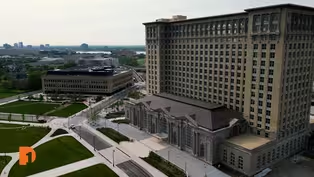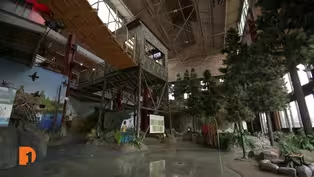
CCH Pounder’s ‘Double ID’ exhibit at The Wright Museum
Clip: Season 9 Episode 1 | 7m 11sVideo has Closed Captions
The Wright Museum opens the “Double ID” exhibit from actress and art collector CCH Pounder.
The Charles H. Wright Museum of African American History has opened "Double ID," a new art exhibit featuring 54 works from the private collection of acclaimed actress CCH Pounder. Running through Oct. 20, the exhibit delves into the representation of Black men through the lens of W.E.B. Du Bois' theory of "double consciousness.” Stephen Henderson talks with Pounder about the works in her exhibit.
Problems playing video? | Closed Captioning Feedback
Problems playing video? | Closed Captioning Feedback
One Detroit is a local public television program presented by Detroit PBS

CCH Pounder’s ‘Double ID’ exhibit at The Wright Museum
Clip: Season 9 Episode 1 | 7m 11sVideo has Closed Captions
The Charles H. Wright Museum of African American History has opened "Double ID," a new art exhibit featuring 54 works from the private collection of acclaimed actress CCH Pounder. Running through Oct. 20, the exhibit delves into the representation of Black men through the lens of W.E.B. Du Bois' theory of "double consciousness.” Stephen Henderson talks with Pounder about the works in her exhibit.
Problems playing video? | Closed Captioning Feedback
How to Watch One Detroit
One Detroit is available to stream on pbs.org and the free PBS App, available on iPhone, Apple TV, Android TV, Android smartphones, Amazon Fire TV, Amazon Fire Tablet, Roku, Samsung Smart TV, and Vizio.
Providing Support for PBS.org
Learn Moreabout PBS online sponsorship- So let's talk about this exhibit.
- Absolutely.
- "Double ID."
It is about black men and the duality, right?
- Yes.
Well, first of all, I should really say that I started off at the Wright with "Queen," which was an all-female show.
And then we talked later on that somebody had mentioned, said, "Well, what about the men?"
- What about the men?
What about us?
- And so I said, "Okay.
Well, the next time I come, we'll do a show on men."
But what I loved about how this was done is that it is couched in the philosophy of W. E. B.
Du Bois, of double consciousness.
And so it was providing paintings that not only were sort of very present on, as you look at them, as you get an idea.
In the moment that you think of double consciousness, you get another idea of what this man may have had to do to present himself in a way that is less threatening one way, as less powerful than he actually is.
And so I thought, "Let's bring up these paintings."
And these were the ones that they chose from my collection.
When somebody approaches me for a museum exhibit, there's a theme, there's something that the curator wants to talk about.
Then when they come, they visit your home, and they choose the pieces.
And now that I see the pieces up, I see that double consciousness.
I see that brutish man that Uthman Wahaab who's behind you, big, and it's the gardener with the shears.
He's just a gardener, but he's massive.
And I can imagine that in certain places where he was walking, he would have to try to make himself quite small so that you see this other person.
- Right.
To disappear, in some ways.
- To disappear in some ways.
Yeah.
And it's how the Wright went about choosing these works.
- So when I walk around and look, I see my grandfather's face, I see my father's face, I see my face, and I see my son's face.
It's remarkable how powerful- - I thank you.
- that is.
- I thank you.
- And as an African-American man, you don't get a chance to do that in many art spaces.
to do that in many, in many art spaces.
- I have to share my first experience with that, It was in Xavier University in sort of a public forum.
And it was in a sort of, what I call, a passage gallery, where students are walking through from one classroom off to another.
Headphones, cell phones, and their books, et cetera.
And to watch these students kind of and have that look of, "Oh my god, that's me, that's me, that's me," it was thrilling.
And that's really what opened my brain to saying, "We cannot just store these and keep them for your own pleasure.
These need to go around the world and be seen by us and really enjoyed by us."
So that was the beginning.
And I realized that even people who would be considered others, who feel like they don't really know African-American people or African-Caribbean people, there is this kind of portal that these paintings provide.
That there is this variety of men, and women, obviously, in the world that you've taken a sort of a one-dimensional look at.
And here's an opportunity to begin to open up your mind to visiting these people.
- [Stephen] Yeah, yeah.
- Making a connection- - Seeing them more fully.
- to see them more fully.
- Yeah.
Yeah.
- Yes.
- Let's talk about this being here in Detroit and at the Wright, which is, of course, a special place in Detroit.
- Well, for me, it's special because Neil Barclay was the first person that said, "You should bring that collection to Detroit," which is fantastic.
And so this is my second time around.
So I feel now, like, Wright is almost like the home for me in terms of my start of showing the works.
And I think Detroit in particular is a type of city that could use an infusion of self.
And so I think this is sort of a good place to come back to.
- Yeah.
So in this part of the exhibit, it's portraits, faces.
The other side is- - More like storytelling.
there's scenes with African men.
And they're quite varied.
I have a sort of political section, what I would call about draft.
Like, African men have been drafted.
Football, drafted for sports.
Drafted to be in service.
Enduring slavery, to be drafted in a particular kind of servitude.
Service that you must render to others.
And so there's that.
And then there are scenes of our colonial past, where there's a wonderful painting, a very large painting of Greg Bailey's, of a barrister or lawyer getting dressed, modern day, still having to put on the powdered wig.
- The wig?
(laughs) - Yes.
And then it's what I call the "Sag God."
It's by Fahamu Pecou.
Which really kind of relates to our very young citizens, with the pants that are well below the waistline, hanging off of the hip and creating a kind of, his own personal god, in a sense.
So sort of reinventing himself the way he wants to see himself.
So there is, again, what I call the rainbow of black men.
And that's available to be seen in the big room.
There's a painting that that's on your right, behind you.
It's a giant head.
And everyone has said, "Oh, you know, is he sleeping?
Is he alive?"
And when I spoke to the artist and said, "What's that giant head about?"
and he said he remembers seeing those giant Olmec stones across Mexico and Central America.
- Oh, wow.
- And that he noticed that between Mexico to the Central America, they became more and more black featured.
- They get darker.
Yeah.
- And so he started to paint these enormous black-featured men.
- Wow.
- And so it was, like, stunning.
I have to say, though, seeing it here in the museum, it sort of fits in.
When I first saw it in his studio, it was like, this is enormous.
- It's too big, right?
- Yeah.
It fits in perfectly.
- Yeah.
Yeah.
That's what museums are for, right?
- Yes, they are.
They really are.
It brings everything into perspective.
It's really beautiful.
(upbeat music)
Ford Piquette Avenue Plant Museum preserves Detroit history
Video has Closed Captions
Clip: S9 Ep1 | 5m 2s | The Ford Piquette Avenue Plant Museum is working to preserve Detroit’s automotive history. (5m 2s)
Michigan Central Station reopens after historic renovation
Video has Closed Captions
Clip: S9 Ep1 | 5m 3s | Michigan Central Station reopens to the public after a six-year restoration process. (5m 3s)
Outdoor Adventure Center brings Michigan’s outdoors inside
Video has Closed Captions
Clip: S9 Ep1 | 4m 21s | Outdoor Adventure Center brings Michigan’s outside in to experience nature and recreation. (4m 21s)
Providing Support for PBS.org
Learn Moreabout PBS online sponsorship
- News and Public Affairs

Top journalists deliver compelling original analysis of the hour's headlines.

- News and Public Affairs

FRONTLINE is investigative journalism that questions, explains and changes our world.












Support for PBS provided by:
One Detroit is a local public television program presented by Detroit PBS


